#Leptobrachium
Explore tagged Tumblr posts
Text



Emei Mustache Toad aka Taosze Spiny Toad, (Leptobrachium boringii), family Megophryidae, Sichuan, China
ENDANGERED.
The larger males grow keratinized spines on the upper lip, which they use to defend territories, during the breeding season. The spines fall off after the breeding season.
photographs by Spark Chou
361 notes
·
View notes
Text
Look, I don't think any of us were ready for Leptobrachium ailaonicum
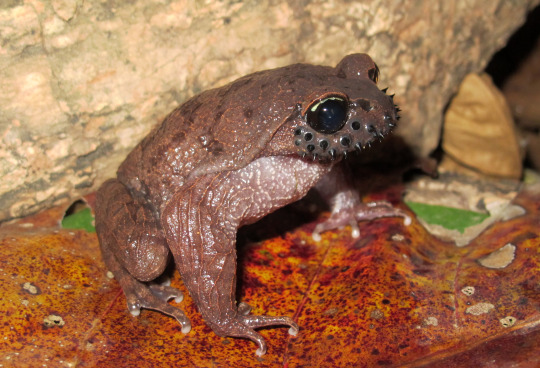
[img src]
#frog#frogs#science#animals#herpetology#He is swole#He has green eyeliner#And his face is covered in spines#This has got to be the most metal frog#by a considerable margin#I cannot get over the fact that the spines go all the way up the side of the face#and that ARM#I mean#if the moustache doesn't make you swoon#at least my boi is BUILT#Leptobrachium#Leptobrachium ailaonicum#cw: trypophobia
5K notes
·
View notes
Text
All glory to the Bufobecue
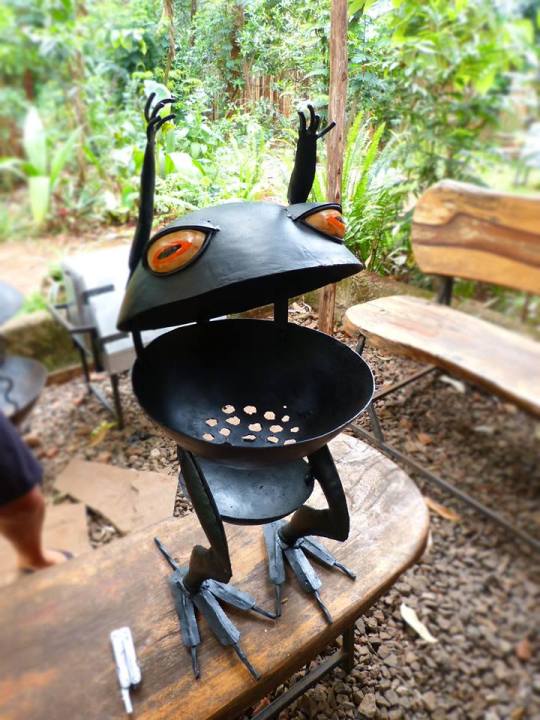
BLAAARGH!! PUT THE COALS WITHIN MY MOUTH! ROAST YOUR FOOLISH MARSHED MALLOWS!! COLLECT THE ASHES FROM MY ASS TRAY and dispose of them responsibly, especially if they are still warm, fires are no joke. Uh. BLAARGH!!
#the eyes look like Leptobrachium#so maybe Leptobrabecue would be a better name#but far be it from me to stymie the creative genius of randomencounters
43K notes
·
View notes
Text

My phylogeny of frog monsters as of the release of wilds
The toxin toads: The most basal of this family of monstrous amphibians, these creatures can be found in a variety of habitats and take the chemical defenses common among frogs to the next level. Of the four species known, three can spew an aerosolized concoction from their mouths in self-defense, with the fourth regurgitating an explosive chyme. These toxins are potent enough to affect creatures hundreds of times their size upon contact, making them a handy species for hunters to use. It’s currently thought that these toxins are synthesized from their diet of bugs.
These creatures are, despite their basal position, already very distinct from other frogs. The genus has two sails supported by bony extensions of the ribs, a feature unique to them, which supports a dense network of blood vessels that can be constricted. This feature can be used to thermoregulate in the wide variety of environments they can be found in, constricting and reducing blood flow in cold environments to retain heat and flushing with blood to vent heat in hot environments.
The toxin toads also have very short tails, which is a feature common amongst this family. This is actually very weird for a frog as ordinarily they re-absorb their tails when transitioning from a tadpole to an adult, and genes responsible for the particular shape of the hip bones in frogs is also intrinsically linked with the re-absorption of the tail in their tadpole stage. The re-absorption of the tail allows for the specialized muscles and unique hip structure that allows frogs to jump to be present. Because of this, you can only really have one or the other.
It could be possible that the tails of the monster frogs could be extensions of the colon like the Tailed Frog, but we don’t see them squash or stretch like a boneless appendage and instead move like they have a rigid support structure. This doesn’t necessarily mean that they have vertebrae in their tails, but this is the logical conclusion. And if they are true tails then that implies that this family either descend from very early frogs or stem-frogs, splitting off before the loss of the tail as adults became hard baked into the genome of other frogs. This would also imply that their hips, and by extension how they leap, is very different from other frogs.
Armored frogs
Thorntoad: Amphibians native to the citadel and by extension the mega-forest it once was, in self defense they vomit noxious chemicals into the faces of attackers. This isn’t all too different from the toxin toads, implying that this could be an ancestral trait to the family.
Two defining features of this species are their long flexible tongues and armor.
Despite what is seen in media, frog tongues are not long or especially flexible. They are actually short and situated at the front of the mouth folded backwards, and when a frog opens its mouth to grab something the tongue flips forward into a more normal position to slap the prey item with its stickiness. So for a frog to have a long flexible tongue like that of say an anteater is rather fascinating, and could imply a diet specializing in animals that make small burrows. Unable to dig prey up, it simply sends its tongue down to probe for it.
The osteoderms, which are common among the monster frogs, is also strange as frogs famously lack scales. But that isn’t to say that they are unfamiliar with doing strange things with their skin, as many species have hard bony skin around the face and shoulders, and Leptobrachium boringii males can grow a mustache of keratinous spines during mating season. In a land with dragons and dinosaurs, large frogs might be pressured into dermal protection.
Chatacabra: Monstrous frogs with long tongues and upright limbs native to deserts. Chatacabra are perhaps most unique for their body plan that has converged with the cursorial old world monkeys such as Blagonga and Rajang, and they seem to have near similar range of movement in their limbs and can even knuckle walk. What could have possibly caused such an adaptation in a frog is unclear. While a more upright body posture would keep the underside off the hot sand, the arms are subject to guesswork. The unique range of arm movements in primates is a result of their arboreality and brachiation movements, so it could be possible that the ancestors of Chatacabra were arboreal.
The long tongue of Chatacabra seems to be a holdover from more basal armored frogs, and while still used for prey capture, is also used to smear the forelimbs with sticky mucus. This same mucus is used to attach rocks to their forelimbs to make their attacks more damaging to anything willing to attack them.
Three features present in Chatacabra are common to the rest of the monstrous frogs and is worth bringing up here. Teeth on the mandibles, claws, and supporting the organs without a ribcage.
Frogs lack teeth on their bottom jaws as they lost the genes for them 200 million years ago, but it is not impossible for the monstrous frogs to have re-evolved them. The frog Gastrotheca guentheri managed to do it, likely because the genes that tell teeth were to grow are tied to the genes for gums. Claws are also not impossible for a frog when faced with the right pressure, as the African Clawed Frog has keratinous extensions on three of its toes it uses for prey processing.
Frogs also don’t have a rib cage, and ordinarily this limits how big they can get as past a certain size their organs might threaten to fall out of their body or get jostled around. But the monstrous frogs get around this with very well developed obliquus externus and rectus abdominis muscles with a high amount of elastin to prevent damage when getting jostled around. They also have hypertrophied procoracoids, sternums, and xiphisternums to further mimic a proper ribcage.
In the desert there is rarely large long lasting water bodies for tadpoles, so Chatacabra had to develop a work-around. Much like Rain Frogs, Chatacabra mothers will dig a hole for her to lay eggs in, and these eggs will give birth to miniature fully formed Chatas via a process called direct development.
Tetranadon: Amphibians that can be found in river systems in more eastern parts of the world, Tetras are unique for their hard turtle-like shell and beak.
The species spends most time submerged and inactive for long stretches of time, as long wisps of algae are commonly seen growing off their bodies. They occasionally experience periods of activity where they forage along the bottom of water bodies, shuffling through the muck with their fleshy bill. This bill is lined with electroreceptors like a platypus, and they use it to detect prey, particularly a species of freshwater slug called Goocumbers, which is their preferred prey. Upon detection a Tetranadon then ravenously scarfs down its meal, along with the surrounding water and dirt.
The shell of a Tetranadon is composed of many large fused osteoderms, but unlike a turtle shell it is completely separate from the ribs and vertebrae. Tetranadon are also capable of standing and moving upright, and can even pick up objects with their forelimbs.
Tetsucabra: Possibly the most famous genus within this froggy family, Tetsucabra are a common sight in habitats with rocky terrain.
The species is fossorial, and creates elaborate dens and tunnels with their large claws and massive tusks. Their skulls are notoriously robust and their tusks and brows give them an intimidating appearence. They are equipped with rather flat peg shaped teeth, and this coupled with the fact they are capable of eating grains and rice indicates an omnivorous diet. Tetsu are also smart enough to be trained and tamed individuals exist, although they are very food motivated creatures.
If their powerful legs and massive jumps are unable to carry them to safety, their tough hide and powerful bite can deter attackers. They can even manipulate boulders with their mouths and toss them as well as spit a noxious substance much like the Thorn Toad and Toxin Toads.
During the breeding season male Tetsucabra fight violently for females like African Bullfrogs. A successful male will then dig out a nursery for his offspring that he maintains diligently.
Inflatable frogs
Zamitrios: Arctic amphibians known for their striking appearance, massive maw, and rapid metamorphic lifecycle.
The primary species is found around the polar seaway and its surrounding environments, and deals with the temperatures through antifreeze compounds in the blood and gigantothermy. The species is aquatic, swimming with powerful webbed feet and a fluked tail after prey which they dispatch via shark-like jaws and teeth. But they need to be careful not to fall prey to other monsters such as the massive parave Ukanlos.
They drink seawater, and their specialized kidneys can filter out the salt. In self defense they can spray some of their water reserves along with bits of liquid nitrogen from groves along their hide. In the freezing temperatures of their habitat this instantly freezes over their body to form ice armor. If that fails they can suck in a bunch of air to inflate themselves and make themselves look bigger.
Zamtrios tadpoles are already born with forelimbs and have large jagged cranial horns. They target large animals and drill into their hides to eat them alive from the inside, and then rapidly metabolize their meals to grow into subadults. Subadults are very similar to juveniles but have proper hind limbs. This rapid growth is a defensive mechanism, as without parental care it is in a juvenile’s best interest to grow big quickly since in such harsh arctic environments any predator is willing to make a quick snack of them.
There exists a desert dwelling subspecies that, as a water retention adaptation, has lost the ability to create ice armor.
Tricktoad: A small member of the family that takes the inflatable abilities of Zamtrios to the next level. Lighter than air gases are retained from their digestive system and used to float. They then use various fins to (clumsily) propel themselves. In self defense they can secrete a substance that smells good to large predators before making a hasty getaway in hopes of eliminating a would-be predator.
Yama Tsukami: Traditionally put in the slight wastebasket taxon that is the elder dragon class, its placement here is controversial. Not much is known about the species.
Yama spend very long periods of time on the forest floor of the forests and jungles they call home, long enough that flora grows on their skin and adds a layer of camouflage. Occasionally they experience periods of activity where they then proceed to quite literally inhale plants and any animals not fast enough to escape its massive maw, which is equipped with massive human-like teeth perfect for processing woody material. Great Thunderbugs also live symbiotically within their mouths where they keep it mostly clean of debris, plaque, and cavities.
They accomplish flight via the same way as Tricktoads, but instead of using fins for propulsion they use gas and inhaled air that is vented from “gills” on their underside. So reliant are Yama on floating for movement that the muscles in their limbs have atrophied and their skeleton isn’t ossified outside of their jaws as a weight saving adaptation. If they ever find themselves grounded they are incapable of movement until able to re-inflate.
As the species is very poorly understood, their reproductive habits are a mystery. But Mezeporta hunters have reported a variation of the monster called Yama Kurai, although these are likely just very old Yamas.
Other notes
Gelidron: A recently discovered species of giant salamander native to the oilwell basin. They live their lives in the slow lane in groups, lazily foraging for various endemic crustaceans. To navigate rough terrain they are equipped with claws and gecko-like foot pads.
They’re able to gradually shift their color to be darker when in oilslits and their iridescent mucus further aids in this camouflage. If threatened they open their mouths as a threat display, but are otherwise easy and nutritious meals. They primarily rely on their explosive reproduction for defense.
Yes I know I wouldn’t have needed to make various workarounds for these guys if I just made them Temnospondyls instead of frogs but shhhh let me have some fun and talk about weird frogs and frog anatomy.
#monster hunter#monhun#monster hunter biology#monsterhunter#speculative biology#speculative evolution#speculative zoology#taxonomy#phylogenetics#phylogeny#cladistics#tetsucabra#amphibians#zamtrios#chatacabra#yama tsukami#paratoad
60 notes
·
View notes
Note
give the frog post back they were totally relevant pls i must observe them
Humans and non humans, this is the curse of owning sideblogs.
Every now and then you get a "Kirby wants your Femur" moment.
But since you asked nicely, here ya go!
Have a frogge.
13 notes
·
View notes
Text

frog asexual pride flag!
featuring: Leptobrachium lunatum Chiromantis xerampelina Phyllobates terribilis Nasikabatrachus sahyadrensis
#amphibians#amphibian#frogs#asexual#aroace#acespec#acesexual#ace#lgbt#pride#pride month#lgbt pride#lgbtqia#pride 2024#queer pride
6 notes
·
View notes
Text
Anuran Species Diversity and Microhabitat Preferences in Secondary Forest and Riverine Areas of Tangub City, Philippines

Abstract
The research study focused on the diversity and microhabitat preferences of anuran species in secondary forests and riverine areas in Tangub City, Misamis Occidental. It was particularly conducted in three different elevations (upper, mid, and lower) at Barangay Manga and Barangay Hoyohoy. Visual Encounter Survey and Capture-mark-release methods were used. Fifteen (15) species belonging to six (6) families were identified from 276 individuals captured, namely: Ansonia mcgregori, Ansonia muelleri, Ingerophrynus philippinicus, Rhinella marina, Fejevarya vittigera, Hoplobatrachus rugulosus, Limnonectes leytensis, Limnonectes magnus, Kalophrynus sinensis, Kaloula pulchra, Leptobrachium lumadorum, Megophrys stejnegeri, Leptomantis bimaculatos, Polypedates leucomystax, and Pulchrana grandocula, of which eleven species are endemics and four species are non-endemics. Both study areas attained moderate species diversity, however Barangay Hoyohoy showed a higher similarity index among all sampling sites. Most anuran species encountered preferred aquatic microhabitats, with Pulchrana grandocula as the most abundant species (69.99%) observed. Relative humidity as an environmental factor influenced its abundance in each sampling area. Primary threats such as human disturbances and habitat destruction were observed in Barangay Manga. Thus, researchers recommend conservation strategies and enforcement of policies to protect the study areas as well as anurans assemblage.

Introduction
Anurans are crucial in the food web, particularly for insect control, and serve as natural bioindicators of ecosystem health (Mohagan et al., 2018). Their sensitivity to environmental changes makes them valuable indicators of ecological integrity and watershed health. The Philippine archipelago is one of the most mega-diverse countries in the world, hosting a large number of endemic plant and animal species, particularly in its rainforests (Lavides et al., 2004). Mindanao, situated in the southern region of the Philippines, is considered home to various endemic species (Diesmos et al., 2015). According to Solania and Fernandez-Gamalinda (2018), there were 141 individuals of anurans recorded, of which 73% were Philippine endemics, and 36% were Mindanao faunal endemics. However, a large portion of Mindanao remains unexplored (Dela Torre and Nuñeza, 2021), and many new species are still being described (Siler et al., 2009).
Anurans utilize both terrestrial and aquatic microhabitats, exhibiting overlap in microhabitat preferences (Plaza and Sanguila, 2015). Anurans are most likely to seek cooler microhabitats with lower temperatures and higher relative humidity (Aureo and Bande, 2019). Their dependence on moist conditions and high humidity means that amphibian diversity is highest in regions with high precipitation and lower evaporative water loss (West, 2018). For decades, amphibian populations faced decline due to habitat destruction, overexploitation, quarrying, land conversion, and alteration of habitat that favors invasive species, which threaten native amphibian species (Mapi-ot et al., 2015). Currently, more than 150,300 species are recorded according to the IUCN Red List (2023), with over 42,100 species considered threatened with extinction, including 41% of amphibian species. Thus, the presence of potentially threatened anurans implies a need for conservation measures for species protection.
Research beyond Mt. Malindang to lowland areas, where anuran populations are more vulnerable to disturbances, is needed (Nuneza et al., 2010). Tangub City, sheltered by Mt. Malindang and Panguil Bay, faces threats to its anuran habitats due to human population growth and deforestation (Nuneza et al., 2010). Barangay Hoyohoy shows potential as a tourist destination, while Barangay Manga is crucial for irrigation and water quality maintenance. Understanding anurans in these areas is essential for ecosystem health and conservation. To bridge this gap, researchers undertook a comprehensive study aimed to identify the diversity and microhabitat preferences of anuran species in secondary forest and riverine areas of Tangub City, Misamis Occidental. The findings serve as baseline data for the policymakers to improve conservation and management efforts and highlight local awareness as to their role in maintaining anuran diversity.
Source : Anuran Species Diversity and Microhabitat Preferences in Secondary Forest and Riverine Areas of Tangub City, Philippines | InformativeBD
0 notes
Photo

Spotted litter frog (Leptobrachium hendricksoni)
Photo by Steven Wong
#spotted litter frog#leptobrachium hendricksoni#leptobrachium#leptobrachiinae#megophryidae#pelobatoidea#mesobatrachia#anura#batrachia#amphibia#tetrapoda#vertebrata#chordata
2K notes
·
View notes
Photo
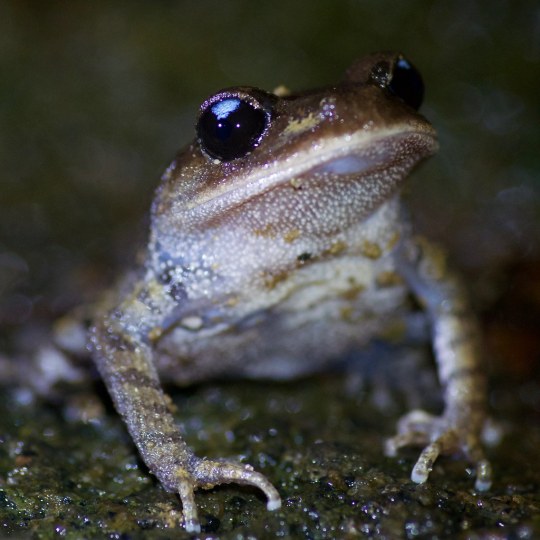
Leptobrachium banae by Jean R.
#Anura#Megophryidae#Leptobrachium#Leptobrachium banae#toad#toads#frog#frogs#animal#animals#biology#nature#wildlife#amphibian#amphibians#zoology#herpetology#herps#fauna#critter#critters
434 notes
·
View notes
Photo

Integrative taxonomic analysis reveals a new species of Leptobrachium (Anura: Megophryidae) from north-eastern Cambodia and central Vietnam
Bryan L. Stuart, Hannah E. Som, Thy Neang, Huy Duc Hoang, Duong Thi Thuy Le, Vinh Quang Dau, Kathy Potter & Jodi J. L. Rowley
ABSTRACT
Species boundaries within the red-eyed Leptobrachium of southern Indochina have been uncertain. Leptobrachium pullum and L. mouhoti from upper and lower elevations, respectively, of the Langbian Plateau of southern Vietnam and eastern Cambodia differ in body size but have relatively low interspecific mitochondrial DNA divergence, leading to speculation that these might represent a single species with an elevational cline in body size.
The recent discovery of an allopatric high-elevation population of red-eyed Leptobrachium on the Kon Tum Plateau (= Central Highlands) of north-eastern Cambodia and central Vietnam has been referred to both species, and to a putatively undescribed species.
We examine variation in morphology of adults and tadpoles, mitochondrial DNA, 11 nuclear genes and advertisement calls, and show corroborating lines of evidence for the existence of three species of red-eyed Leptobrachium in southern Indochina.
Although the three species are reciprocally monophyletic in mitochondrial DNA, their shallow mitochondrial DNA divergences are not mirrored by morphology, advertisement calls, or – in part – nuclear DNA, and probably reflect past mitochondrial introgression rather than recent speciation. The Central Highlands taxon is described herein as a new species.
Read the paper here:
https://www.tandfonline.com/doi/abs/10.1080/00222933.2020.1756498?journalCode=tnah20
92 notes
·
View notes
Text

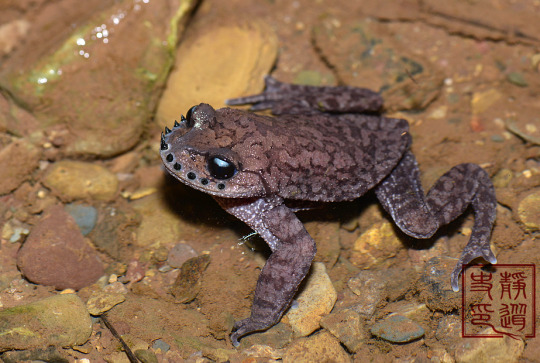
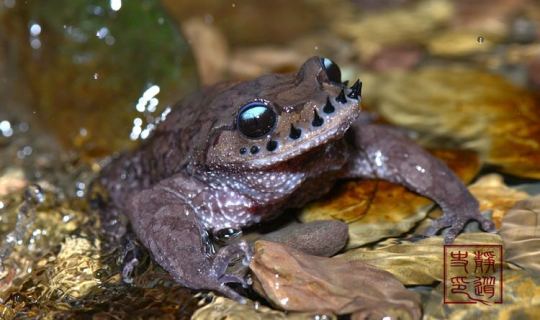


Emei Mustache Toad aka Taosze Spiny Toad, (Leptobrachium boringii), family Megophryidae, endemic to SE China
ENDANGERED.
The larger males grow keratinized spines on the upper lip, which they use to defend territories, during the breeding season. The spines fall off after the breeding season.
photographs: Hudson and Fu; Jingsong Shi; ChinaFotoPress
9K notes
·
View notes
Note
I have a question. Out of all the amphibians you can think of, which have the most protuberant, goofy-looking, bug eyes? Like, I know most frogs and toads have pretty bulging eyes but there's gotta one or two species that take that up to eleven? Love your blog, it's a really nice mix of informative and fluffiness.
Oof, this is a tough one. Really had to give it some thought.
Purple frogs, Nasikabatrachus, have eyes that look like they have been glued onto a ball of clay:

Photo: Sandeep Das
But I feel like that's not what you're going for.
I think perhaps the most strikingly bulbous eyes belong to frogs of the genus Leptobrachium

[src] L. hendricksoni
These frogs have such huge heads—and then in those heads such huge eyes—that they really look like they were drawn by a cartoonist.
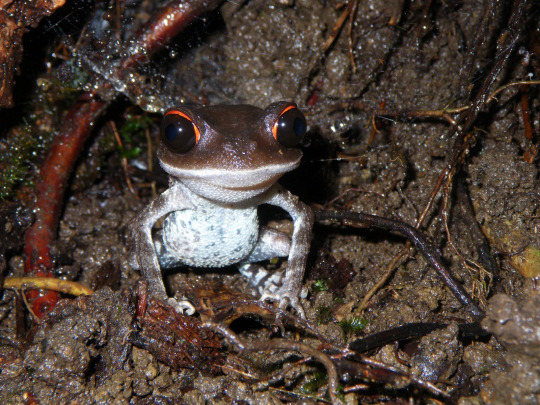
[src] L. lunatum
#frog#frogs#animals#zoology#herpetology#I feel like there are some out there that I am definitely not recalling right now#so please add to the list if you can#but Leptobrachium are pretty extreme#taking it to 11?#well maybe 10.5#Nasikabatrachus#Nasikabatrachus sahyadrensis#Leptobrachium#Leptobrachium lunatum#Leptobrachium hendricksoni#Answers by Mark
915 notes
·
View notes
Text
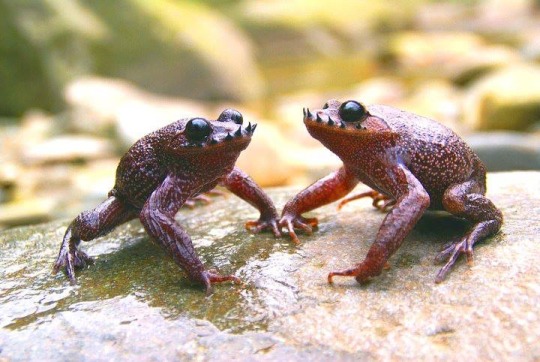

Emei Moustache Toad (Leptobrachium boringii)
these fancy gentlemen grow stiff upper lip spikes during breeding season to fight for territories! named after one of their very few habitats in the world (Mount Emei, China) and for those sweet, sweet ‘staches.
photo credit: x , x
#emei moustache toad#frogs#frogcore#amphibians#cottagecore#frog#frogblr#frogposting#toad#toadblr#Leptobrachium boringii#this was requested by my femme so gen: enjoy your freaks ♥️
380 notes
·
View notes
Text
Wow, I was not expecting 131 votes on this.
About 55 people voted frog, including me.
About 4 voted salamander, which to my knowledge is what the amphibian monsters canonically are… for some reason. Probably kanji pun reasons.
About 17 voted reptilimorph.
About 33 voted Temnospondyl.
And about 21 voted other/multiple. (Dire-Miralis accidentally clicked Temnospondyl when he meant this).
(I know that only adds up to 130, I’m not good at math)
A lot of people made very good points and logically Temnospondyl is the best answer for these guys, but I voted frog and now that the poll is over I’ll share my reason for my vote in more detail.
So the monster hunter amphibians have teeth on their lower jaw, scales, tails, no rib cage if we assume they’re salamanders or frogs, and claws. Distinct features that separate them from frogs. At least most of them.
Frogs lost the genes for teeth on their mandibles 200 million years ago, but it is possible for them to re-evolve them. The frog Gastrotheca guentheri managed to do it, possibly because the genes that tell teeth were to grow are tied to the genes for gums, but that’s my educated guess and could be wrong.

Claws are also something frogs can evolve if they face pressure for it. For instance the African Clawed Frog has keratinous extensions of the toes that help cut up prey.

Scales is a little harder though. For tetsucabra at least I remember some item drops in generations saying the scales are more like toad warts in texture, but I can’t find the item drop that says that so I might have Mandela effected myself. Regardless, frogs can do weird stuff with their skin such as the hairy frog, and in a land of dragons and dinosaurs I’d imagine they’d be pressured into evolving osteoderms. Leptobrachium boringii males can grow a mustache of keratinous spines during mating season.

Frogs also don’t have a rib cage, and that is a limiting factor in how big they can get. But the monhun frogs could get around this with very well developed obliquus externus and rectus abdominis muscles with a high amount of elastin to prevent damage when getting jostled around, and that could be good enough for monhun’s fast and loose approach to physics.
The tails are probably the main point against the frog theory though. It is possible that the tails of the monhun frogs are actually extensions of the cloaca like the tailed frog, but we don’t really see them squash and stretch like a boneless appendage and instead move like they have an internal rigid support structure. Now that doesn’t necessarily mean that they have vertebrae in their tails… but it’s the most logical answer. And if the tails are actually true tails, then this implies things about their hips.
The genes responsible for the particular shape of the hip bones in frogs is also intrinsically linked with the re-absorption of the tail in their tadpole stage. The re-absorption of the tail allows for the specialized muscles and unique hip structure that allows frogs to jump to be present. Because of this, you can only really have one or the other. If Tetsucabra, Zamtrios, and Tetranadon have true tails, then they’re likely accomplishing their great leaps in a way very different from other frogs.
But my greatest reason for voting frogs, my great Hail Mary…
Is that I just find frogs to be very endearing animals and I have a fondness for the amphiterra project, so I like to headcanon the monhun amphibians as frogs.
youtube
Thank you everyone for voting in this poll!




#monster hunter#speculative biology#speculative evolution#monsterhunter#monhun#monster hunter biology#phylogenetics#phylogeny#cladistics#taxonomy#tetsucabra#tetranadon#zamtrios
60 notes
·
View notes
Photo

Thai spadefoot toad (Leptobrachium hendricksoni), Thailand.
Photo credit: Nature Picture Library/Alamy Stock Photo
#nature picture library#alamy stock photo#photographer#thai spadefoot toad#amphibian#toad#leptobrachium hendricksoni#thailand#nature
71 notes
·
View notes
Link
1 note
·
View note